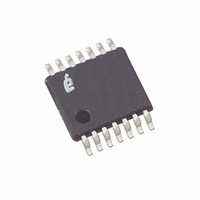X95820UV14I-2.7 Intersil, X95820UV14I-2.7 Datasheet - Page 10

X95820UV14I-2.7
Manufacturer Part Number
X95820UV14I-2.7
Description
IC XDCP DUAL 256TAP 50K 14-TSSOP
Manufacturer
Intersil
Series
XDCP™r
Datasheet
1.X95820WV14IZ-2.7T1.pdf
(12 pages)
Specifications of X95820UV14I-2.7
Taps
256
Resistance (ohms)
50K
Number Of Circuits
2
Temperature Coefficient
45 ppm/°C Typical
Memory Type
Non-Volatile
Interface
I²C, 2-Wire Serial
Voltage - Supply
2.7 V ~ 5.5 V
Operating Temperature
-40°C ~ 85°C
Mounting Type
Surface Mount
Package / Case
14-TSSOP
Resistance In Ohms
50K
Lead Free Status / RoHS Status
Contains lead / RoHS non-compliant
Available stocks
Company
Part Number
Manufacturer
Quantity
Price
Company:
Part Number:
X95820UV14I-2.7
Manufacturer:
Intersil
Quantity:
266
All I
condition, which is a HIGH to LOW transition of SDA while
SCL is HIGH. The X95820 continuously monitors the SDA
and SCL lines for the START condition and does not
respond to any command until this condition is met (See
Figure 15). A START condition is ignored during the power
up sequence and during internal non-volatile write cycles.
All I
condition, which is a LOW to HIGH transition of SDA while
SCL is HIGH (See Figure 15). A STOP condition at the end
of a read operation, or at the end of a write operation to
volatile bytes only places the device in its standby mode. A
STOP condition during a write operation to a non-volatile
byte, initiates an internal non-volatile write cycle. The device
enters its standby state when the internal non-volatile write
cycle is completed.
An ACK, Acknowledge, is a software convention used to
indicate a successful data transfer. The transmitting device,
either master or slave, releases the SDA bus after
transmitting eight bits. During the ninth clock cycle, the
2
2
C interface operations must begin with a START
C interface operations must be terminated by a STOP
SDA
SCL
SDA Output from
SDA Output from
SCL from Master
Transmitter
Receiver
Signals from the
Signals from the
START
Signal at SDA
10
START
FIGURE 15. VALID DATA CHANGES, START, AND STOP CONDITIONS
Master
X95820
FIGURE 16. ACKNOWLEDGE RESPONSE FROM RECEIVER
High Impedance
S
a
t
r
t
FIGURE 17. BYTE WRITE SEQUENCE
1
STABLE
DATA
0
Identification
1
1
0
Byte
A2A1A0
CHANGE
DATA
X95820
0
Write
A
C
K
0 0 0 0
STABLE
DATA
receiver pulls the SDA line LOW to acknowledge the
reception of the eight bits of data (See Figure 16).
The X95820 responds with an ACK after recognition of a
START condition followed by a valid Identification Byte, and
once again after successful receipt of an Address Byte. The
X95820 also responds with an ACK after receiving a Data
Byte of a write operation. The master must respond with an
ACK after receiving a Data Byte of a read operation
A valid Identification Byte contains 1010 as the four MSBs,
and the following three bits matching the logic values
present at pins A2, A1, and A0. The LSB in the Read/Write
bit. Its value is “1” for a Read operation, and “0” for a Write
operation (See Table 2).
Address
Byte
(MSB)
1
TABLE 2. IDENTIFICATION BYTE FORMAT
0
A
C
K
8
Logic values at pins A2, A1, and A0 respectively
1
STOP
Data
Byte
0
ACK
High Impedance
9
A2
A
C
K
S
o
p
t
A1
A0
(LSB)
R/W
July 18, 2006
FN8212.2












